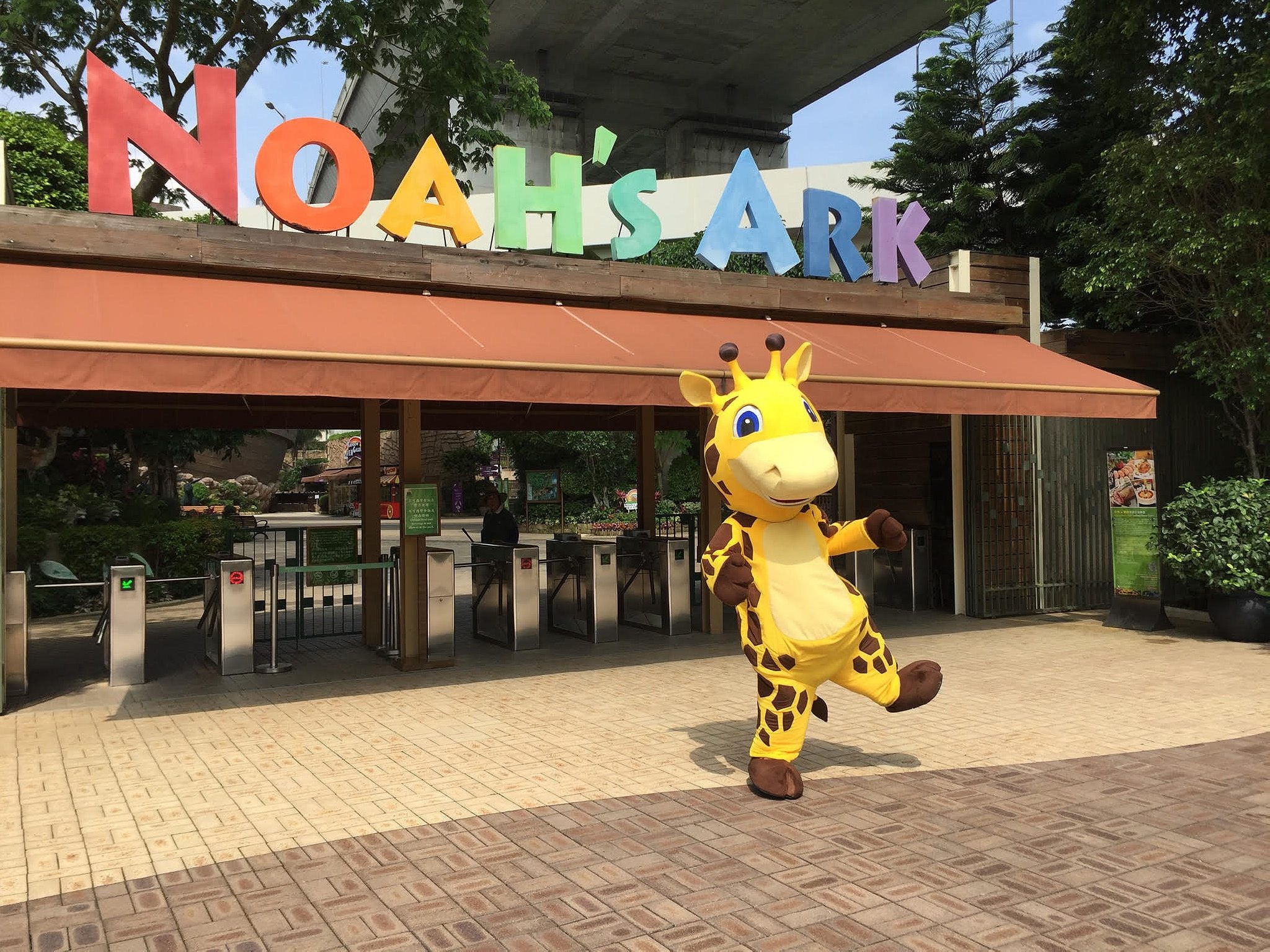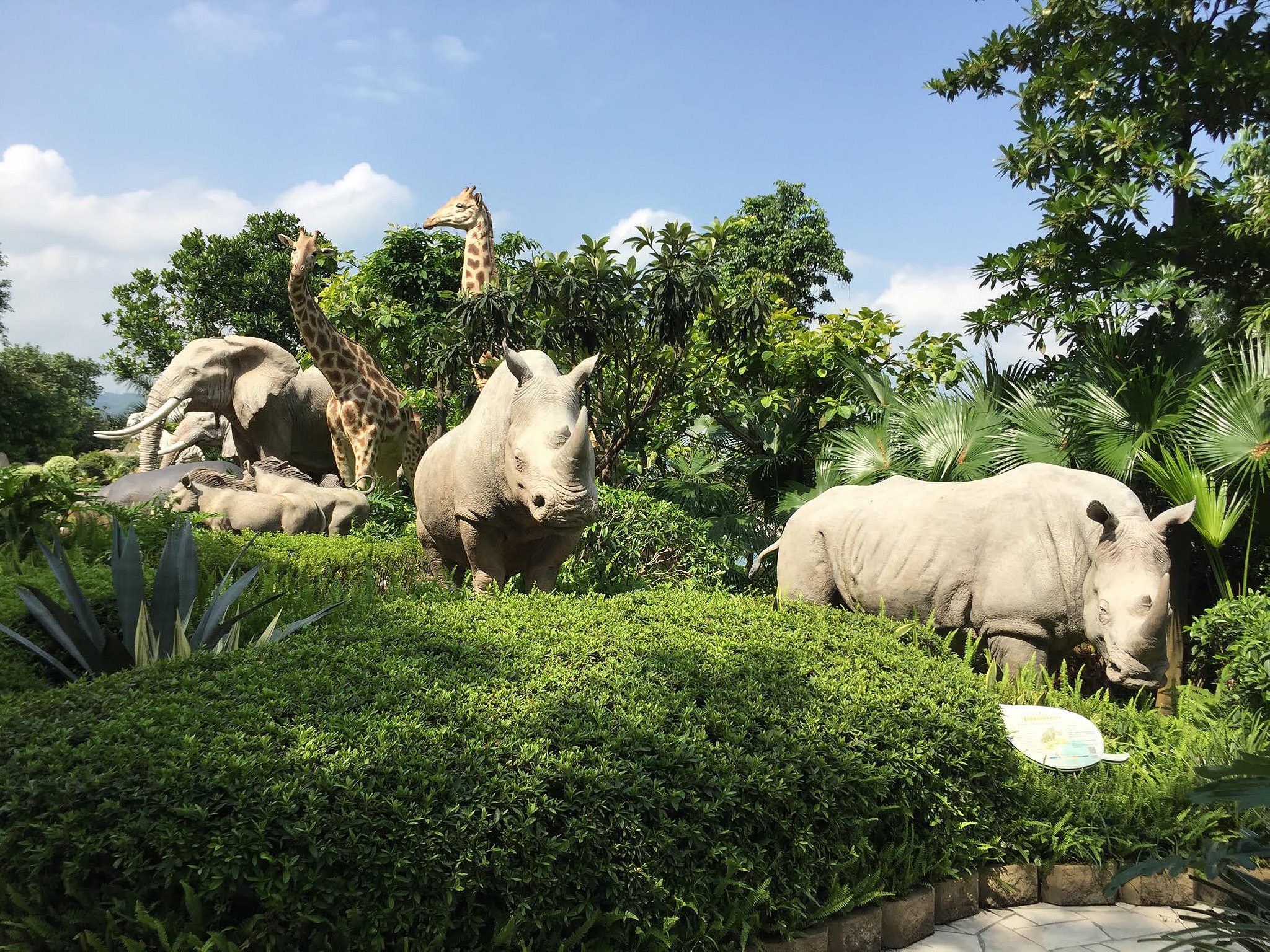When Disney passed on Ma Wan island, the Hong Kong government built the world’s most surreal creationist attraction.
A performer wearing a plush giraffe suit stands outside a small turnstile below rainbow-colored lettering that spells out “Noah’s Ark.” The giraffe takes a few bows. My chipper tour guide, Larry, wearing a headset and screaming yellow polo shirt, asks me if I want to pose for a picture. I tell him I’m alright for now.
The entrance to Hong Kong’s Noah’s Ark theme park is located at the end of the impressive Tsing Ma Bridge, one of the world’s largest suspension bridges, connecting the small island of Ma Wan to the rest of the ever-developing city. Ma Wan used to be a fishing village without roads or public transportation. But since the theme park was built in 2009—in a government purchase lasting 21 years—the island has seen rapid transformation. Bus stations surround the park and cars shoot down the bridge, atop of which it’s impossible to ignore a large brown ship lodged into the ground.
The Ark replica is, naturally, the theme park’s centerpiece. On the day of my visit, Zoe Choy, the park’s administrative assistant, speed walks to the turnstile to greet me. Then she tells me that Sun Hung Kai, the Hong Kong mega-property developers behind the park, made a fiberglass replica of the ship to match the exact size of the Ark in the Old Testament—27,000 square feet, according to the park’s communications team. As we walked past the turnstile I can’t help but notice that there were no visitors at all on a sunny and temperate Wednesday at 3 p.m.
The park administrations say this is the only operating Noah’s Ark theme park in the world, although there’s another on the way. In Kentucky, a Christian fundamentalist is now spending some $102 million to build a controversial Noah’s Ark theme park to preach that the Great Flood will come if America continues with same-sex marriage, atheism, and abortion. Hong Kong’s park isn’t without controversy, either: One of its developers, Thomas Kwok, one of the three founding billionaire brothers of Sun Hung Kai, was sentenced to five years in prison for high-profile corruption unrelated to the park.

Hong Kong doesn’t seem like a natural home for a biblical theme park; Christians only make up between 10 and 20 percent of the city’s population, depending on the survey. But here, the park is not so much about religion as it is the result of the government’s spectacular failure to compete with a global theme park behemoth: Disney.
When Disney first came to Hong Kong in the 1990s, it considered Ma Wan for the location of its park. This is exactly what the Hong Kong government wanted—it had already purchased land on Ma Wan with the intention of selling it for a big payoff to a global developer just like Disney. But Disney believed the island too small for their park and opted instead for Lantau, just 15 minutes down the road. So the government went with the next highest bidder—Sun Hung Kai, which brought in the Noah’s Ark idea—and decided to build a park of its own.
Matthew Pine, the park’s manager who runs its every day affairs, tells me the replica Ark’s origin story: “There was a lawyer that was doing the land transactions between the government and villages, and he was talking to his daughter—an eight-year-old little girl—and she drew a picture of Noah’s Ark,” he said. “Her dad took the picture and brought it to the developers and said, ‘Hey, what do you think of Noah’s Ark?’” Sun Hung Kai found that there wasn’t a single Noah’s Ark-themed attraction in the world, and felt it was a unique enough attraction that it could compete with Disney. It hasn’t exactly worked out that way.
Back at the park entrance, the giraffe leaves us. Larry, Zoe, and I make our way towards the Ark. We walk by what I’m told are 67 pairs of life-size animal sculptures, the skin specially made by Sun Hung Kai to be life-like. We also walk by what looks to me like a very regular tree, but Zoe and Larry say that it’s the Tree of Life, from the story of Adam and Eve.

The Ark, from the outside, doesn’t look much different from an ordinary brown ship. It first strikes me as a massive children’s attractions, but one that features a modern café and a hotel meant to look like a ship deck.
When we enter the five-floor Ark, I’m greeted by Lilly—also wearing the park’s signature yellow polo—carrying a large, squirming tortoise. Taking her fingers down the under side of the shell, she shows me why the turtle is identifiably male from its curvature. She helps take care of the park’s live animals, which include toucans, parakeets, and turtles. Larry has me pick up a heavy ivory elephant’s tusk, and says that man is the elephant’s only enemy. He explains that he warns children on tours against Hong Kong’s thriving ivory trade, which, despite new legislation, will be allowed to continue for five years before it’s banned.
I begin to feel like the Ark might be somewhat of a normal, education-focused museum—that is until we move on to an ultra-futuristic room that seeks to prove Noah’s Ark’s biblical ventilation system, and how the vessel was built on the golden ratio. There are blueprints and replicas of the ancient wood that would have comprised the Ark. Zoe and Larry tell me this room is meant to prove that the Ark was indeed real.
They believe that the wood is proof of the biblical Ark
And that’s when things take an even stranger turn. There’s a wall display showing that in 2003, a Hong Kong-based search team mobilized to prove that Noah’s Ark was real. Called Noah’s Ark Ministries International, very little public information about the organization exists. In 2006, however, the group allegedly discovered petrified wood that drifted to the city from Turkey’s Mount Ararat, where Noah’s Ark landed in the Bible. They sent it to the University of Hong Kong, where, the group claims, scientists proved the wood to be roughly 5,000 years old. The search group believes that the wood is existing proof of the biblical Ark. And now at the theme park, it sits in a large and illuminated porthole glass display.
Next, Larry shows me to an indoor amphitheater. A screen transports us back to a depiction of the Great Flood—a chaotic scene illustrated by Asian characters dressed in togas. A little boy stabs his father and a mother kills her baby, and what appears to be a prostitute begins to dance. Steam pours out from a contraption above the screen and the amphitheater rumbles. When the movie ends, we walk out into a delicately lit display case of randomly collected Noah’s Ark figurines from around the world—some 300, Larry and Zoe tell me—and a gift shop.
We walk outside the Ark, where we’re greeted by a massive block of gleaming apartments overlooking the shore. This is Park Island—an enormous, luxury private housing estate right next door to the Ark. Park Island was also built by Sun Hung Kai, and is one of the development project’s few successes. The villagers originally living on Ma Wan have since been relocated into houses built by the government.
The first of three seven-year phases of the park’s build-operate-transfer deal just ended; in 14 years, Pine doesn’t know what the government has planned for the park, or if it will change ownership. The park is self-financing; the government doesn’t inject any extra funds unless it’s for building and development. Noah’s Ark must rely on ticket sales, which are dropping. Sales have been stymied by transportation regulations in Ma Wan—and in the last two years, Hong Kong’s tourism market has slumped following tensions with Mainland China. Loss is underwritten by Sun Hung Kai.

Before I leave, things get even weirder when I encounter one of the four local NGOs who run activities at the park as a showcase for their work. St. James Settlement oversees an interactive exhibit for what it calls “life education.” The group uses death as an education method, so that, on a basic level, an individual comes to appreciate his life more. The park has turned this into corporate coaching workshops for businessmen.
My visit to the St. James Settlement’s exhibit involves another apocalyptic movie where the world is ending. In an ultra-futuristic Hong Kong facilitated by robots, the population is forced to evacuate as an oncoming meteor threatens global destruction. But I don’t make the space shuttle that brings salvation to everyone else—and with 30 seconds left to live and a piece of paper left on the seat, I need to write down what I would have done differently in my life.
Turns out, the world doesn’t end: the meteor doesn’t hit and I’m saved. The exercise is meant to show that 30 seconds is far too short to express mortal regrets and desires. And then the exhibit’s host removes a dark sheet concealing a black coffin, just beneath the screen. While some have been invited to enter the ventilated coffin and contemplate how much they underappreciate their lives, I’m one of the lucky ones—that’s not what the park has in store for me today.